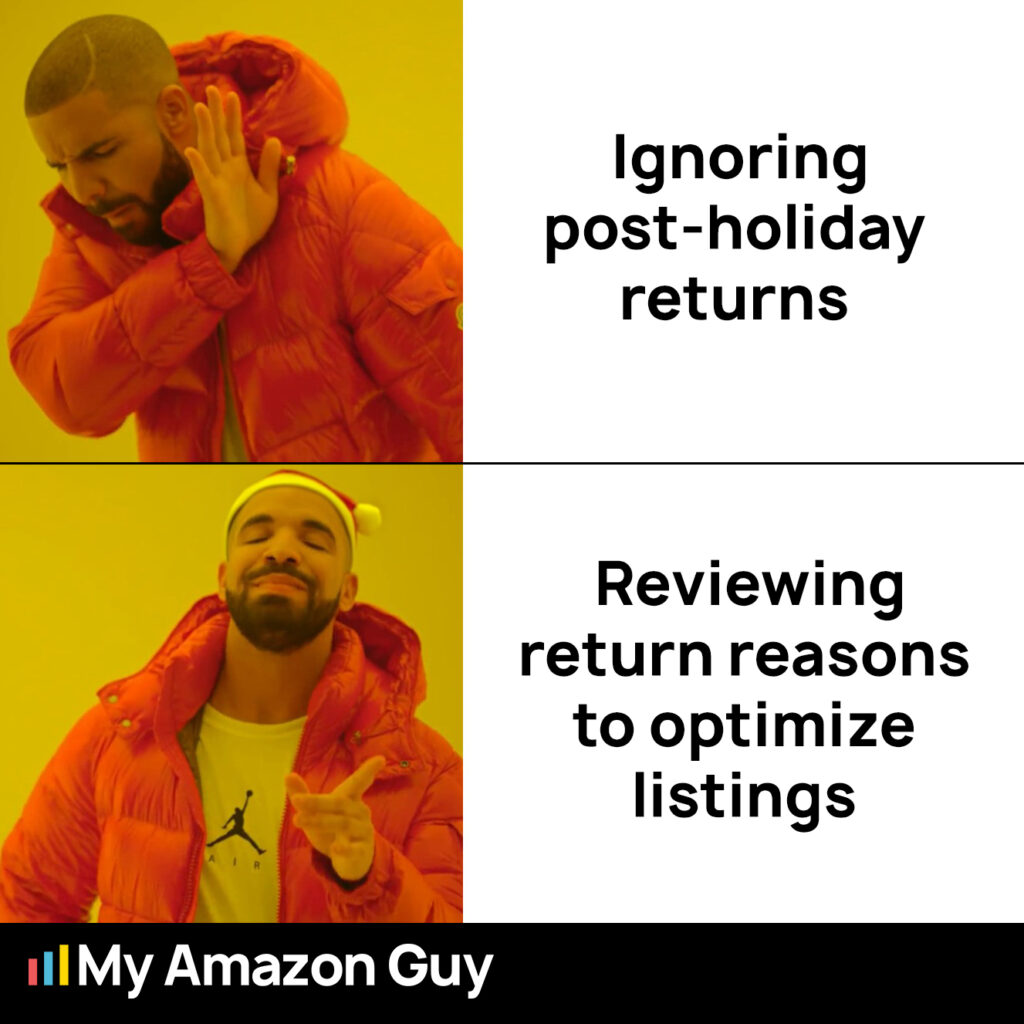
Did you know that you can continue driving sales even after the holiday rush? That’s why having an Amazon post-holiday strategy is key to keeping momentum going in January and beyond.
Most sellers only prepare for Q4 by focusing on what needs to be done before and during the holidays. But the truth is, the period right after the holidays is just as important for protecting profits and building long-term growth.
With the right Amazon post-holiday strategy, you can handle the surge of returns without hurting your account health. You can also turn first-time holiday buyers and gift recipients into loyal repeat customers.
In this guide, our Amazon agency covers the essential Amazon post-holiday strategies every seller needs to succeed, from managing returns and engaging gift recipients to analyzing Q4 performance and turning refunds into loyalty opportunities. We also include practical prep tips, so you can protect profits, strengthen your brand, and carry holiday momentum into the new year.
Table of Contents
Ready to Build a Strong Post-Holiday Plan?
Our full-service Amazon agency can turn seasonal shoppers into long-term loyal buyers.
Why the "Fifth Quarter" Is Critical for Amazon Sellers
Many sellers think Q4 ends in December, but the real opportunity extends into January and early February. This “Fifth Quarter” can make a big difference in sales and long-term growth.
It’s not just about cleaning up after the holiday rush. Sellers who manage returns well, protect account health, and engage new customers set themselves up for success in the new year.
When treated strategically, the Fifth Quarter becomes more than recovery time. It’s a chance to acquire loyal customers, gain market insights, and strengthen your brand for the year ahead.
Amazon Post-Holiday Strategies to Maximize Q4 Momentum
There are proven strategies sellers can apply, or add to their current approach, to maximize sales after the holiday rush. These are the ones that worked for us, and we’re sharing them to help sellers make the most out of this critical period.
Amazon Post-Holiday Strategy 1: Handling Post-Holiday Returns
One of the biggest post-holiday challenges is the spike in returns, often from wrong sizes, duplicate gifts, or unwanted items. With return rates jumping by about 17% higher than the rest of the year, sellers need a clear plan to protect margins and keep customers satisfied.
A. Understanding Amazon's Extended Return Policy
Since many shoppers begin buying gifts well before the holidays, Amazon extends its return window to build confidence in early purchases. This policy ensures customers know they can still return items after the holidays, making it easier to shop without hesitation.
Most items bought between November 1 and December 31 are eligible for return until the end of January. This extended timeframe supports both buyers and sellers by encouraging more sales during peak season while giving recipients plenty of time to decide.
B. Tips for Planning for Returns and Refunds
A big part of post-holiday prep is making sure you’re ready for the inevitable surge of returns and refunds. Planning ahead can help you stay efficient, protect your cash flow, and keep customers satisfied.
- Set aside extra funds to cover the higher volume of refunds.
- Prepare additional staff or extend hours to process returns quickly.
- Automate parts of the returns and refund process to save time.
- Know how FBA will handle returns if you’re enrolled in the program.
- Respond to customer questions early to reduce unnecessary returns.
- Track return data to find patterns and improve for future sales seasons.
C. Using Return Data as a Growth Tool
Returns aren’t just costs, they’re also insights into what’s working and what’s not. By analyzing the reasons behind returns, sellers can improve product quality, fix listing gaps, and even guide future product development.
This data also helps refine marketing and operations, from setting clearer customer expectations to streamlining the returns process. Instead of seeing returns as a loss, treat them as feedback that can drive smarter decisions and long-term growth.
Amazon Post-Holiday Strategy 2: Turn Gift Recipients into Long-Term Customers
During Q4, gift-related searches and purchases surge as shoppers buy for loved ones, which means many of your products end up in the hands of new users. Smart sellers factor this into their post-holiday strategy, using it as an opportunity to turn those gift recipients into loyal customers.
A. Gift Recipients As Your Potential Audience
Gift recipients represent a unique growth opportunity since many Q4 sales end up in the hands of people who didn’t buy the product themselves. The challenge is that they can’t be reached through traditional retargeting, as they have no purchase or browsing history with your brand.
This doesn’t mean they should be ignored, but on the contrary, they’re an untapped audience worth pursuing. Sellers who find ways to connect with gift recipients can expand their customer base and build loyalty long after the holidays are over.
B. How to Engage Gift Recipients Effectively
There are several strategies sellers can use to connect with gift recipients and turn them into repeat customers. Simple but intentional actions can bridge the gap between the physical product they receive and your brand’s digital presence.
- Use Amazon-compliant product inserts that add value, such as warranty registration or usage tips.
- Include a QR code that links directly to your product page or Amazon Brand Store.
- Invest in professional packaging that makes your brand name clear and memorable.
- Encourage recipients to visit your Amazon Brand Store and follow your brand for updates.
- FBM sellers can use gift packaging to add inserts, brand details, or their brand name so recipients get to know the brand.
Turn Post-Holiday Chaos Into Growth
Don’t let returns and missed opportunities slow you down. Our team can help you maximize January momentum.
Amazon Post-Holiday Strategy 3: Review Q4 Performance to Plan for the Year Ahead
Q4 performance reports are more than just numbers; they are blueprints for smarter strategies in the year ahead. Sellers who take the time to analyze results can uncover what worked, what failed, and where to adjust.
A. Financial Review
Start by examining your TACoS trend during Q4 to determine if your advertising spend truly aligned with your objectives. This reveals whether you drove profitable growth or overspent for sales that didn’t deliver long-term value.
Next, calculate the actual profit margin of each major ASIN after factoring in all costs like ad spend, fees, discounts, and returns. This exercise highlights which products are true profit drivers and which may need rethinking.
B. Inventory Performance
Look at how your IPI score shifted from Q4’s peak to Q1 to measure the effect of returns and leftover inventory. This helps you see if stock levels were too high or too low at critical times.
Also, reviewing sell-through rates allows you to refine your inventory strategy for next year. With better forecasting, you can avoid costly overstocks while ensuring your best-sellers never run out.
C. Customer Cohort Analysis
Analyzing your Q4 customer cohort provides valuable insights into future buying behavior. Using tools like AMC or third-party analytics, you can track how often these customers return to purchase again.
Calculating customer lifetime value (CLTV) shows the long-term impact of Q4 acquisition. This data helps you understand whether your holiday investments fueled sustainable growth or only short-term wins.
Amazon Post-Holiday Strategy 4: Make Returns a Customer Loyalty Channel
Did you know that 54% of buyers say free returns or exchanges heavily influence their decision to buy from a brand? This makes it critical for Amazon sellers to simplify the return and refund process to win customer trust.
For many gift recipients, a return or exchange may be their very first direct interaction with your brand. If that process feels smooth and supportive, you’re creating a positive impression that can turn a one-time shopper into a repeat buyer.
Instead of treating returns as a setback, sellers should view them as an onboarding moment for new customers. Adding small touches like friendly communication or even a discount on their next purchase can turn a refund into the start of brand loyalty.
Frequently Asked Questions
How do I handle the spike in Amazon post-holiday returns?
Process returns quickly, issue refunds where needed, and monitor return reasons to improve listings. This protects account health and customer trust.
Is it worth running Amazon PPC campaigns after the holidays?
Yes. Running Amazon PPC campaigns after the holidays is worth it since competition decreases, CPCs drop, and shoppers with gift cards are still buying.
When is the ideal time to send inventory for the holidays?
Send inventory at least 2–3 months before peak season to avoid delays and stockouts. For Q4, aim to have products in Amazon’s warehouse by early October.
Don’t Let Post-Holiday Opportunities Slip Away
Amazon sellers stay busy all year, but the holiday season often takes center stage. In the rush to prepare for Q4, many overlook the importance of planning for what comes after, missing out on revenue and customer retention opportunities.
With this guide, we hope to help you prepare smarter for the Fifth Quarter and beyond. By managing returns well and re-engaging holiday buyers, you can turn a seasonal spike into long-term growth.
Still don’t have a winning Amazon post-holiday strategy? Let our experts handle it. Contact our full-service Amazon agency today.
Struggling With Post-Holiday Returns?
We’ll optimize your strategy so you keep profits high and customers coming back for more.




